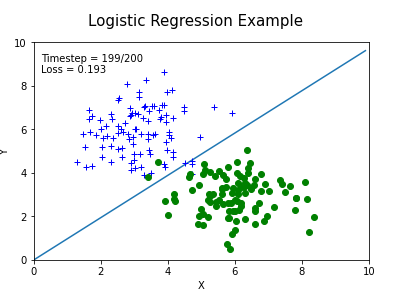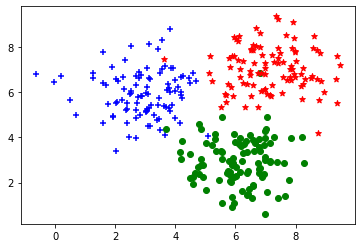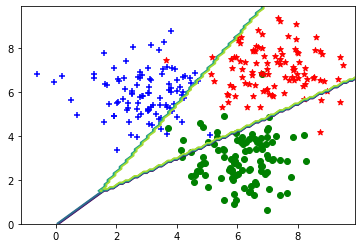1. 逻辑回归解决二分类问题
1.1 生成数据集
-
'+' 从高斯分布采样 (X, Y) ~ N(3, 6, 1, 1, 0).
-
'o' 从高斯分布采样 (X, Y) ~ N(6, 3, 1, 1, 0)
import tensorflow as tf
import matplotlib.pyplot as plt
from matplotlib import animation, rc
from IPython.display import HTML
import matplotlib.cm as cm
import numpy as np
%matplotlib inline
dot_num = 100
x_p = np.random.normal(3., 1, dot_num)
y_p = np.random.normal(6., 1, dot_num)
y = np.ones(dot_num)
C1 = np.array([x_p, y_p, y]).T
x_n = np.random.normal(6., 1, dot_num)
y_n = np.random.normal(3., 1, dot_num)
y = np.zeros(dot_num)
C2 = np.array([x_n, y_n, y]).T
plt.scatter(C1[:, 0], C1[:, 1], c='b', marker='+')
plt.scatter(C2[:, 0], C2[:, 1], c='g', marker='o')
data_set = np.concatenate((C1, C2), axis=0)
np.random.shuffle(data_set)

1.2 建立模型
- 逻辑函数的交叉熵损失函数:
[L = -sum _{i=1}^{n}y_ilog(p_i)+(1-y_i)log(1-p_i)
]
-
(y_i) 指 i 的真实值,(p_i) 指 i 的预测值。
-
下面loss函数中在预测值pred后面加上了epsilon。
epsilon = 1e-12
class LogisticRegression():
def __init__(self):
self.W = tf.Variable(shape=[2, 1], dtype=tf.float32,
initial_value=tf.random.uniform(shape=[2, 1], minval=-0.1, maxval=0.1))
self.b = tf.Variable(shape=[1], dtype=tf.float32, initial_value=tf.zeros(shape=[1]))
self.trainable_variables = [self.W, self.b]
@tf.function
def __call__(self, inp):
logits = tf.matmul(inp, self.W) + self.b #shape(N, 1)
pred = tf.nn.sigmoid(logits)
return pred
@tf.function
def compute_loss(pred, label):
if not isinstance(label, tf.Tensor):
label = tf.constant(label, dtype=tf.float32)
pred = tf.squeeze(pred, axis=1)
'''============================='''
#输入label shape(N,), pred shape(N,)
#输出 losses shape(N,) 每一个样本一个loss
#todo 填空一,实现sigmoid的交叉熵损失函数(不使用tf内置的loss 函数)
#losses = -label*tf.math.log(pred) - (1-label)* tf.math.log(1-pred)
losses = -label*tf.math.log(pred+epsilon) - (1.-label)* tf.math.log(1.-pred+epsilon)
'''============================='''
loss = tf.reduce_mean(losses)
pred = tf.where(pred>0.5, tf.ones_like(pred), tf.zeros_like(pred)) #大于0.5预测正确,否则预测错误,形成判定矩阵
accuracy = tf.reduce_mean(tf.cast(tf.equal(label, pred), dtype=tf.float32)) #计算正确率
return loss, accuracy
@tf.function
def train_one_step(model, optimizer, x, y):
with tf.GradientTape() as tape:
pred = model(x)
loss, accuracy = compute_loss(pred, y)
grads = tape.gradient(loss, model.trainable_variables)
optimizer.apply_gradients(zip(grads, model.trainable_variables))
return loss, accuracy, model.W, model.b
1.3 实例化一个模型,进行训练
if __name__ == '__main__':
model = LogisticRegression()
opt = tf.keras.optimizers.SGD(learning_rate=0.01) #SGD优化器
x1, x2, y = list(zip(*data_set))
x = list(zip(x1, x2))
animation_fram = []
for i in range(200):
loss, accuracy, W_opt, b_opt = train_one_step(model, opt, x, y)
animation_fram.append((W_opt.numpy()[0, 0], W_opt.numpy()[1, 0], b_opt.numpy(), loss.numpy()))
if i%20 == 0:
print(f'loss: {loss.numpy():.4} accuracy: {accuracy.numpy():.4}')
loss: 0.7929 accuracy: 0.08
loss: 0.5811 accuracy: 0.995
loss: 0.4555 accuracy: 0.995
loss: 0.3761 accuracy: 0.995
loss: 0.3223 accuracy: 0.995
loss: 0.2837 accuracy: 0.995
loss: 0.2547 accuracy: 0.995
loss: 0.232 accuracy: 0.995
loss: 0.2139 accuracy: 0.995
loss: 0.199 accuracy: 0.995
1.4 展示动态结果
f, ax = plt.subplots(figsize=(6,4)) #f是图像对象,ax是坐标轴对象
f.suptitle('Logistic Regression Example', fontsize=15)
plt.ylabel('Y')
plt.xlabel('X')
ax.set_xlim(0, 10)
ax.set_ylim(0, 10)
line_d, = ax.plot([], [], label='fit_line')
C1_dots, = ax.plot([], [], '+', c='b', label='actual_dots')
C2_dots, = ax.plot([], [], 'o', c='g' ,label='actual_dots')
frame_text = ax.text(0.02, 0.95,'',horizontalalignment='left',verticalalignment='top', transform=ax.transAxes)
def init():
line_d.set_data([],[])
C1_dots.set_data([],[])
C2_dots.set_data([],[])
return (line_d,) + (C1_dots,) + (C2_dots,)
def animate(i):
xx = np.arange(10, step=0.1)
a = animation_fram[i][0]
b = animation_fram[i][1]
c = animation_fram[i][2]
yy = a/-b * xx +c/-b
line_d.set_data(xx, yy)
C1_dots.set_data(C1[:, 0], C1[:, 1])
C2_dots.set_data(C2[:, 0], C2[:, 1])
frame_text.set_text('Timestep = %.1d/%.1d
Loss = %.3f' % (i, len(animation_fram), animation_fram[i][3]))
return (line_d,) + (C1_dots,) + (C2_dots,)
#FuncAnimation函数绘制动图,f是画布,animate是自定义动画函数,init_func自定义开始帧,即传入init初始化函数,
#frames动画长度,一次循环包含的帧数,在函数运行时,其值会传递给函数animate(i)的形参“i”,interval更新频率,以ms计,blit选择更新所有点,还是仅更新产生变化的点。
anim = animation.FuncAnimation(f, animate, init_func=init, frames=len(animation_fram), interval=30, blit=True)
HTML(anim.to_html5_video())
动态截图:
最终结果:

2. softmax回归解决多分类问题
2.1 生成数据集
-
'+' 从高斯分布采样 (X, Y) ~ N(3, 6, 1, 1, 0).
-
'o' 从高斯分布采样 (X, Y) ~ N(6, 3, 1, 1, 0)
-
'*' 从高斯分布采样 (X, Y) ~ N(7, 7, 1, 1, 0)
import tensorflow as tf
import matplotlib.pyplot as plt
from matplotlib import animation, rc
from IPython.display import HTML
import matplotlib.cm as cm
import numpy as np
%matplotlib inline
dot_num = 100
x_p = np.random.normal(3., 1, dot_num)
y_p = np.random.normal(6., 1, dot_num)
y = np.ones(dot_num)
C1 = np.array([x_p, y_p, y]).T
x_n = np.random.normal(6., 1, dot_num)
y_n = np.random.normal(3., 1, dot_num)
y = np.zeros(dot_num)
C2 = np.array([x_n, y_n, y]).T
x_b = np.random.normal(7., 1, dot_num)
y_b = np.random.normal(7., 1, dot_num)
y = np.ones(dot_num)*2
C3 = np.array([x_b, y_b, y]).T
plt.scatter(C1[:, 0], C1[:, 1], c='b', marker='+')
plt.scatter(C2[:, 0], C2[:, 1], c='g', marker='o')
plt.scatter(C3[:, 0], C3[:, 1], c='r', marker='*')
data_set = np.concatenate((C1, C2, C3), axis=0)
np.random.shuffle(data_set)

2.2 建立模型
-
建立模型类,定义loss函数,定义一步梯度下降过程函数
-
填空一:在
__init__构造函数中 建立模型所需的参数 -
填空二:实现softmax的交叉熵损失函数(不使用tf内置的loss 函数)
softmax的交叉熵损失函数:
[R(W) = -frac{1}{N}sum _{n=1}^{N}sum _{c=1}^{C}y_{c}^{(n)}logp_{c}^{n}=-frac{1}{N}sum _{n=1}^{N}(y^{n})^{T}logp^{n} \
(y 指真实值,p指预测值.)
]
下面loss函数中在预测值pred后面加上了epsilon。
epsilon = 1e-12
class SoftmaxRegression():
def __init__(self):
'''============================='''
#todo 填空一,构建模型所需的参数 self.W, self.b 可以参考logistic-regression-exercise
'''============================='''
# 3个输出
self.W = tf.Variable(shape=[2, 3], dtype=tf.float32,
initial_value=tf.random.uniform(shape=[2,3], minval=-0.1, maxval=0.1))
self.b = tf.Variable(shape=[1, 3], dtype=tf.float32,
initial_value=tf.zeros(shape=[1,3]))
self.trainable_variables = [self.W, self.b]
@tf.function
def __call__(self, inp):
logits = tf.matmul(inp, self.W) + self.b # shape(N, 3)
pred = tf.nn.softmax(logits)
return pred
@tf.function
def compute_loss(pred, label):
label = tf.one_hot(tf.cast(label, dtype=tf.int32), dtype=tf.float32, depth=3)
'''============================='''
#输入label shape(N, 3), pred shape(N, 3)
#输出 losses shape(N,) 每一个样本一个loss
#todo 填空二,实现softmax的交叉熵损失函数(不使用tf内置的loss 函数)
losses = -tf.reduce_mean(label*tf.math.log(pred+epsilon))
'''============================='''
loss = tf.reduce_mean(losses)
accuracy = tf.reduce_mean(tf.cast(tf.equal(tf.argmax(label,axis=1), tf.argmax(pred, axis=1)), dtype=tf.float32))
return loss, accuracy
@tf.function
def train_one_step(model, optimizer, x, y):
with tf.GradientTape() as tape:
pred = model(x)
loss, accuracy = compute_loss(pred, y)
grads = tape.gradient(loss, model.trainable_variables)
optimizer.apply_gradients(zip(grads, model.trainable_variables))
return loss, accuracy
2.3 实例化一个模型,进行训练
model = SoftmaxRegression()
opt = tf.keras.optimizers.SGD(learning_rate=0.01)
x1, x2, y = list(zip(*data_set))
x = list(zip(x1, x2))
for i in range(1000):
loss, accuracy = train_one_step(model, opt, x, y)
if i%50==49:
print(f'loss: {loss.numpy():.4} accuracy: {accuracy.numpy():.4}')
loss: 0.3136 accuracy: 0.4233
loss: 0.2784 accuracy: 0.6833
loss: 0.2534 accuracy: 0.7933
loss: 0.2347 accuracy: 0.8467
loss: 0.2202 accuracy: 0.8733
loss: 0.2086 accuracy: 0.88
loss: 0.1989 accuracy: 0.8867
loss: 0.1908 accuracy: 0.8867
loss: 0.1839 accuracy: 0.8933
loss: 0.1779 accuracy: 0.9033
loss: 0.1725 accuracy: 0.9067
loss: 0.1678 accuracy: 0.9133
loss: 0.1636 accuracy: 0.9133
loss: 0.1598 accuracy: 0.9133
loss: 0.1563 accuracy: 0.9133
loss: 0.1532 accuracy: 0.9133
loss: 0.1503 accuracy: 0.9167
loss: 0.1476 accuracy: 0.9167
loss: 0.1451 accuracy: 0.92
loss: 0.1428 accuracy: 0.92
2.4 结果展示
plt.scatter(C1[:, 0], C1[:, 1], c='b', marker='+')
plt.scatter(C2[:, 0], C2[:, 1], c='g', marker='o')
plt.scatter(C3[:, 0], C3[:, 1], c='r', marker='*')
x = np.arange(0., 10., 0.1)
y = np.arange(0., 10., 0.1)
X, Y = np.meshgrid(x, y)
inp = np.array(list(zip(X.reshape(-1), Y.reshape(-1))), dtype=np.float32)
print(inp.shape)
Z = model(inp)
Z = np.argmax(Z, axis=1)
Z = Z.reshape(X.shape)
plt.contour(X,Y,Z)
plt.show()
(10000, 2)
